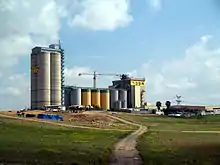Food storage
Food storage allows food to be eaten for some time (typically weeks to months) after harvest rather than solely immediately. It is both a traditional domestic skill and, in the form of food logistics, an important industrial and commercial activity. Food preservation, storage, and transport, including timely delivery to consumers, are important to food security, especially for the majority of people throughout the world who rely on others to produce their food. Food is stored by almost every human society and by many animals. Storing of food has several main purposes:
- Storage of harvested and processed plant and animal food products for distribution to consumers
- Enabling a better balanced diet throughout the year
- Reducing kitchen waste by preserving unused or uneaten food for later use
- Preserving pantry food, such as spices or dry ingredients like rice and flour, for eventual use in cooking
- Preparedness for catastrophes, emergencies and periods of food scarcity or famine
- Religious reasons (Example: LDS Church (aka:The Church of Jesus Christ of Latter Day Saints) leaders instruct church members to store food)[1]
- Protection from animals or theft


Domestic food storage


The safe storage of food for home use should strictly adhere to guidelines set out by reliable sources, such as the United States Department of Agriculture. These guidelines have been thoroughly researched by scientists to determine the best methods for reducing the real threat of food poisoning from unsafe food storage. It is also important to maintain proper kitchen hygiene, to reduce risks of bacteria or virus growth and food poisoning. The common food poisoning illnesses include Listeriosis, Mycotoxicosis, Salmonellosis, E. coli, Staphylococcal food poisoning and Botulism. There are many other organisms that can also cause food poisoning.[2]
There are also safety guidelines available for the correct methods of home canning of food. For example, there are specific boiling times that apply depending upon whether pressure canning or waterbath canning is being used in the process. These safety guidelines are intended to reduce the growth of mold and bacteria and the threat of potentially-fatal food poisoning.
Freezers and thawing food
Freezer temperature should be maintained below 0 °F (−18 °C). Food should never be thawed at room temperature, this increases the risk of bacterial and fungal growth and accordingly the risk of food poisoning. Once thawed, food should be used and never refrozen. Frozen food should be thawed using the following methods:[3]
- Microwave oven
- During cooking
- In cold water (place food in watertight, plastic bag; change water every 30 minutes)
- In the refrigerator
Throw out foods that have been warmer than 40 °F (4 °C) for more than 2 hours. If there is any doubt at all about the length of time the food has been defrosted at room temperature, it should be thrown out. Freezing does not destroy microbes present in food. Freezing at 0 °F does inactivate microbes (bacteria, yeasts and molds). However, once food has been thawed, these microbes can again become active. Microbes in thawed food can multiply to levels that can lead to foodborne illness. Thawed food should be handled according to the same guidelines as perishable fresh food.[4]
Food frozen at 0 °F and below is preserved indefinitely. However, the quality of the food will deteriorate if it is frozen over a lengthy period. The United States Department of Agriculture, Food Safety and Inspection Service publishes a chart showing the suggested freezer storage time for common foods.[4]
Refrigeration
It is important to note that safe food storage using refrigeration requires adhering to temperature guidelines:
For safety, it is important to verify the temperature of the refrigerator. Refrigerators should be set to maintain a temperature of 40 °F (4 °C) or below. Some refrigerators have built-in thermometers to measure their internal temperature. For those refrigerators without this feature, keep an appliance thermometer in the refrigerator to monitor the temperature. This can be critical in the event of a power outage. When the power goes back on, if the refrigerator is still 40 °F, the food is safe. Foods held at temperatures above 40 °F for more than 2 hours should not be consumed. Appliance thermometers are specifically designed to provide accuracy at cold temperatures. Be sure refrigerator/freezer doors are closed tightly at all times. Don’t open refrigerator/freezer doors more often than necessary and close them as soon as possible.[5]
Storage times for refrigerated food
The United States Department of Agriculture, Food Safety and Inspection Service publishes recommended storage times for refrigerated food.[5]
Storing oils and fats
Oils and fats can begin to go rancid quickly when not stored safely. Rancid cooking oils and fats do not often smell rancid until well after they have spoiled. Oxygen, light and heat all contribute to cooking oils becoming rancid. The higher the level of polyunsaturated fat that an oil contains, the faster it spoils. The percentage of polyunsaturated fat in some common cooking oils is: safflower (74%); sunflower (66%); corn (60%); soybean (37%); peanut (32%); canola (29%); olive (8%); coconut (5%).[6]
To help preserve oils from rancidification, they should be stored in a dark place, stored in oxygen-safe, light-reducing containers (e.g. dark glass or metal). Once opened, oils should be refrigerated and used within a few weeks, when some types begin to go rancid. Unopened oils can have a storage life of up to one year, but some types have a shorter shelf-life even when unopened (such as sesame and flaxseed).[6]
Dry storage of foods
Vegetables

The guidelines vary for safe storage of vegetables under dry conditions (without refrigerating or freezing). This is because different vegetables have different characteristics, for example, tomatoes contain a lot of water, while root vegetables such as carrots and potatoes contain less. These factors, and many others, affect the amount of time that a vegetable can be kept in dry storage, as well as the temperature needed to preserve its usefulness.[7] The following guideline shows the required dry storage conditions:[8]
- Cool and dry: onion, List of Allium species
- Cool and moist: root vegetable, potato, cabbage
- Warm and dry: winter squash, pumpkin, sweet potatoes, dried hot peppers
Many cultures have developed innovative ways of preserving vegetables so that they can be stored for several months between harvest seasons. Techniques include pickling, home canning, food dehydration, or storage in a root cellar.
Grain
Grain, which includes dry kitchen ingredients such as flour, rice, millet, couscous, cornmeal, and so on, can be stored in rigid sealed containers to prevent moisture contamination or insect or rodent infestation. For kitchen use, glass containers are the most traditional method. During the 20th century plastic containers were introduced for kitchen use. They are now sold in a vast variety of sizes and designs.
Metal cans are used (in the United States the smallest practical grain storage uses closed-top #10 metal cans). Storage in grain sacks is ineffective; mold and pests destroy a 25 kg cloth sack of grain in a year, even if stored off the ground in a dry area. On the ground or damp concrete, grain can spoil in as little as three days, and the grain might have to be dried before it can be milled. Food stored under unsuitable conditions should not be purchased or used because of risk of spoilage. To test whether grain is still good, it can be sprouted. If it sprouts, it is still good, but if not, it should not be eaten.[9] It may take up to a week for grains to sprout. When in doubt about the safety of the food, throw it out as quickly as possible.
Spices and herbs
Spices and herbs are today often sold prepackaged in a way that is convenient for pantry storage. The packaging has dual purposes of both storing and dispensing the spices or herbs. They are sold in small glass or plastic containers or resealable plastic packaging. When spices or herbs are homegrown or bought in bulk, they can be stored at home in glass or plastic containers. They can be stored for extended periods, in some cases for years. However, after 6 months to a year, spices and herbs will gradually lose their flavour as oils they contain will slowly evaporate during storage.
Spices and herbs can be preserved in vinegar for short periods of up to a month without losing flavor, creating a flavoured vinegar.
Alternative methods for preserving herbs include freezing in water or unsalted butter. Herbs can be chopped and added to water in an ice cube tray. After freezing, the ice cubes are emptied into a plastic freezer bag for storing in the freezer. Herbs also can be stirred into a bowl with unsalted butter, then spread on wax paper and rolled into a cylinder shape. The wax paper roll containing the butter and herbs is then stored in a freezer, and can be cut off in the desired amount for cooking. Using either of these techniques, the herbs should be used within a year.
Meat
Unpreserved meat has only a relatively short life in storage. Perishable meats should be refrigerated, frozen, dried promptly or cured. Storage of fresh meats is a complex discipline that affects the costs, storage life and eating quality of the meat, and the appropriate techniques vary with the kind of meat and the particular requirements.[10] For example, dry ageing techniques are sometimes used to tenderize gourmet meats by hanging them in carefully controlled environments for up to 21 days, while game animals of various kinds may be hung after shooting. Details depend on personal tastes and local traditions.[11] Modern techniques of preparing meat for storage vary with the type of meat and special requirements of tenderness, flavour, hygiene, and economy.[12]
Semi-dried meats like salamis and country style hams are processed first with salt, smoke, sugar, acid, or other "cures" then hung in cool dry storage for extended periods, sometimes exceeding a year. Some of the materials added during the curing of meats serve to reduce the risks of food poisoning from anaerobic bacteria such as species of Clostridium that release botulinum toxin that can cause botulism. Typical ingredients of curing agents that inhibit anaerobic bacteria include nitrates. Such salts are dangerously poisonous in their own right and must be added in carefully controlled quantities and according to proper techniques. Their proper use has however saved many lives and much food spoilage.
Like the semi-dried meats, most salted, smoked, and simply-dried meats of different kinds that once were staples in particular regions, now are largely luxury snacks or garnishes; examples include jerky, biltong, and varieties of pemmican, but ham and bacon for instance, still are staples in many communities.
Food rotation
Food rotation is important to preserve freshness. When food is rotated, the food that has been in storage the longest is used first. As food is used, new food is added to the pantry to replace it; the essential rationale is to use the oldest food as soon as possible so that nothing is in storage too long and becomes unsafe to eat. Labelling food with paper labels on the storage container, marking the date that the container is placed in storage, can make this practice simpler. The best way to rotate food storage is to prepare meals with stored food on a daily basis.[13]
For emergency preparation
Guides for surviving emergency conditions in many parts of the world recommend maintaining a store of essential foods; typically water, cereals, oil, dried milk, and protein rich foods such as beans, lentils, tinned meat and fish. A food storage calculator can be used to help determine how much of these staple foods a person would need to store in order to sustain life for one full year. In addition to storing the basic food items many people choose to supplement their food storage with frozen or preserved garden-grown fruits and vegetables and freeze-dried or canned produce. An unvarying diet of staple foods prepared in the same manner can cause appetite exhaustion, leading to less caloric intake. Another benefit to having a basic supply of food storage in the home is for the potential cost savings. Costs of dry bulk foods (before preparation) are often considerably less than convenience and fresh foods purchased at local markets or supermarkets. There is a significant market in convenience foods for campers, such as dehydrated food products.
Commercial food logistics

Grain and beans are stored in tall grain elevators, almost always at a rail head near the point of production. The grain is shipped to a final user in hopper cars. In the former Soviet Union, where harvest was poorly controlled, grain was often irradiated at the point of production to suppress mold and insects. In the U.S., threshing and drying is performed in the field, and transport is nearly sterile and in large containers that effectively suppresses pest access, which eliminates the need for irradiation. At any given time, the U.S. usually has about two weeks worth of stored grains for the population.
Fresh fruits and vegetables are sometimes packed in plastic packages and cups for fresh premium markets, or placed in large plastic tubs for sauce and soup processors. Fruits and vegetables are usually refrigerated at the earliest possible moment, and even so have a shelf life of two weeks or less.
In the United States, livestock is usually transported live, slaughtered at a major distribution point, hung and transported for two days to a week in refrigerated rail cars, and then butchered and sold locally. Before refrigerated rail cars, meat had to be transported live, and this placed its cost so high that only farmers and the wealthy could afford it every day. In Europe much meat is transported live and slaughtered close to the point of sale. In much of Africa and Asia most meat is for local populations is raised, slaughtered and eaten locally, which is believed to be less stressful for the animals involved and minimizes meat storage needs. In Australia and New Zealand, where a large proportion of meat production is for export, meat enters the cold chain early, being stored in large freezer plants before being shipped overseas in freezer ships.
Food storage facilities
Silo: these are used to store grains like wheat and maize.
See also
- Canning
- Candying
- Food science
- Food and bioprocess technology
- Food chemistry
- Food engineering
- Food safety
- Food microbiology
- Food technology
- Dietary supplement
- Food dehydration
- Food fortification
- Food preservation
- Food rheology
- Food storage container
- Food supplement
- Hoarding (animal behavior)
- Nutraceutical
- Pickling
- Preserves
- Root cellar
- Shaker-style pantry box
References
- "Provident Living." Archived 2011-10-29 at the Wayback Machine, Latter Day Saints Family Home Storage.
- Marotz, Lynn R. (2008). Health, Safety, and Nutrition for the Young Child. Wadsworth Publishing. pp. 491–2. ISBN 978-1-4283-2070-3.
- Marotz, Lynn R. (2008). Health, Safety, and Nutrition for the Young Child. Wadsworth Publishing. pp. 482. ISBN 978-1-4283-2070-3.
- "Fact Sheet: Freezing and Food Safety". United States Department of Agriculture, Food Safety and Inspection Service. June 3, 2010. Archived from the original on November 12, 2011. Retrieved November 8, 2011.
- "Refrigeration and Food Safety" (PDF). United States Department of Agriculture, Food Safety and Inspection Service. May 2010. Archived from the original (PDF) on 2013-02-20. Retrieved 2011-11-08.
- Mitchell, Deborah (2004). Safe foods: the A-to-Z guide to the most wholesome foods for you and your family. Penguin. pp. Ch. 15. ISBN 978-1-101-21015-4.
- "Vegetable harvest and storage". University of Missouri. Retrieved August 21, 2011.
- "How to dry and store the vegetables you've grown". Vegetable Expert. Retrieved August 21, 2011.
- "The Big Thaw". www.fsis.usda.gov. Retrieved 2018-02-05.
- Michael Richardson, Kim Matthews, Chris Lloyd, Katie Brian. Meat quality and shelf life. Better Returns Programme EBLEX Agriculture and Horticulture Development Board. brp_b_betterreturnsfrommeatmanual-meatqualityandshelflife.pdf
- Editors of Creative Publishing. Dressing & Cooking Wild Game. Publisher: Creative Publishing international 1999 ISBN 978-0865731080
- Matthews, K. R. Review of published literature and unpublished research on factors influencing beef quality. EBLEX R&D UK Agriculture and Horticulture Development Board 2011 rd_qs_b_-_meatqualityreview2010-beef.pdf from Archived 2013-03-24 at the Wayback Machine
- Food Storage Guidelines, Family Survival Planning, April 10, 2009.
